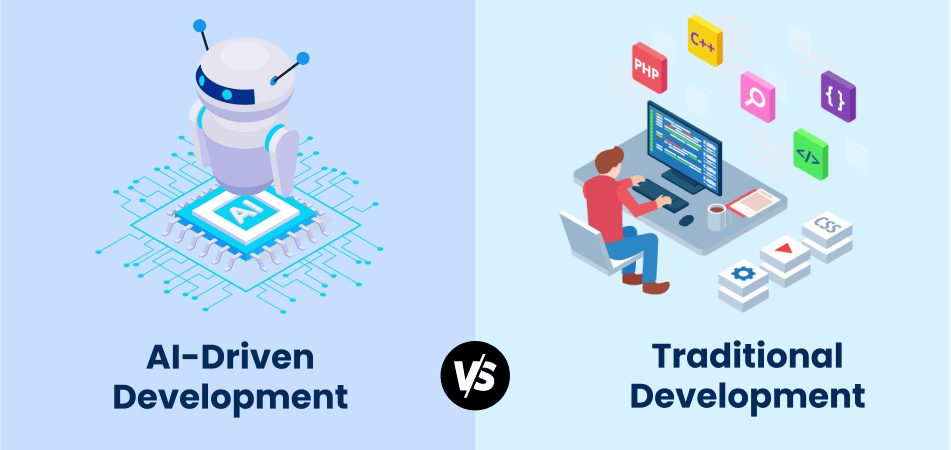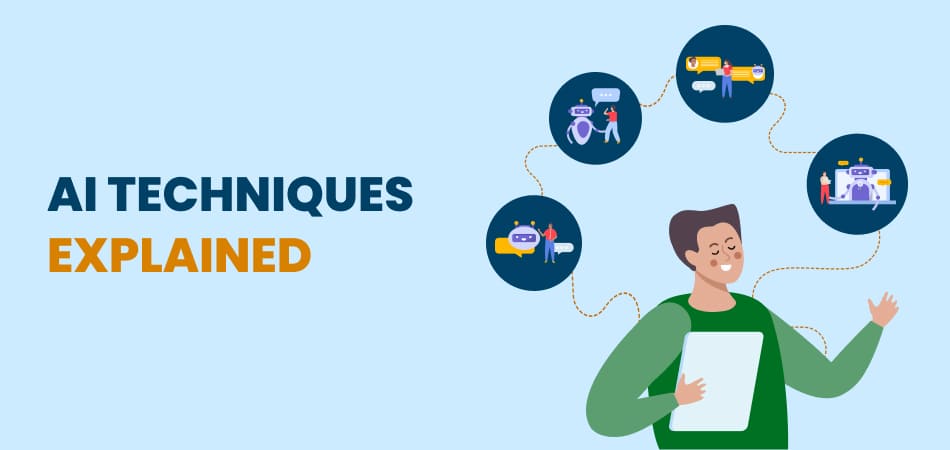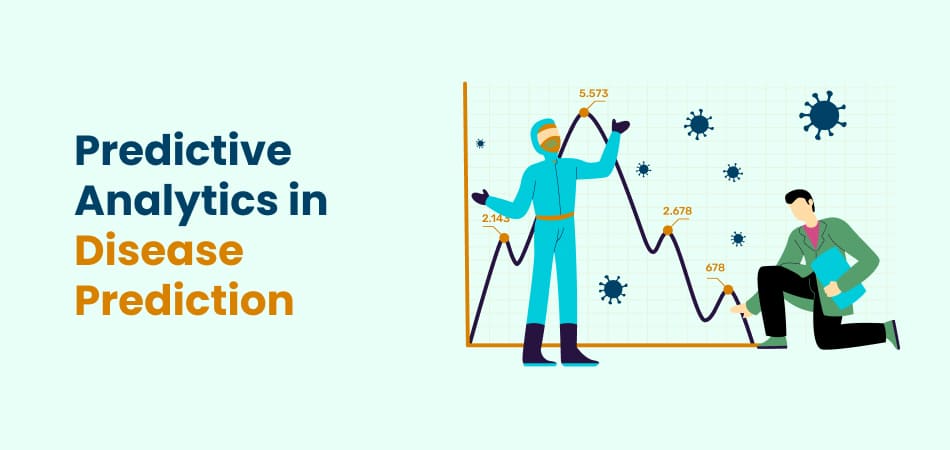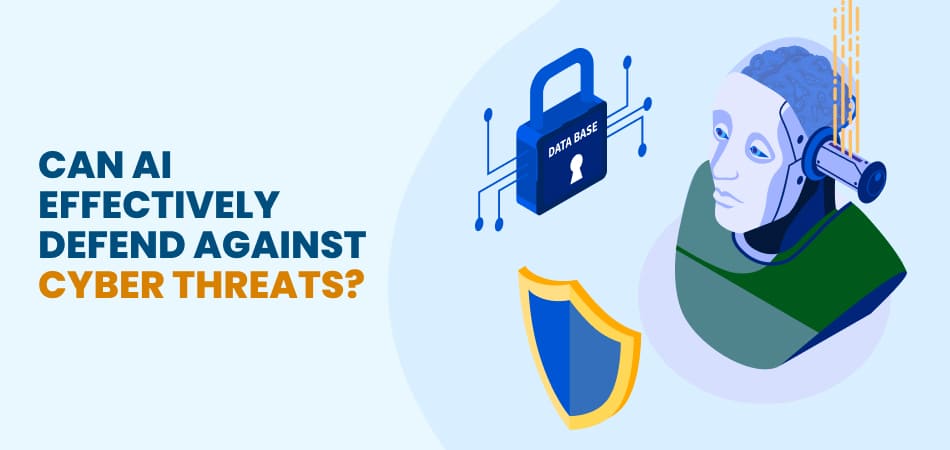The software development landscape has undergone a tremendous transformation over the years, especially with the advent of artificial intelligence (AI). The contrasting methodologies of AI-driven development and traditional development mark a significant shift in how software is created, tested, and maintained. Understanding the key differences between these two approaches is crucial for businesses and developers to make informed decisions about which methodology best suits their needs. This extended blog delves into the key differences between AI-driven and traditional development, elaborating on their unique characteristics, advantages, and challenges.
Understanding AI-Driven Development
AI-driven development represents a paradigm shift in software engineering, leveraging advanced artificial intelligence technologies and methodologies. This approach integrates machine learning algorithms, natural language processing (NLP), and other AI techniques to automate and enhance various facets of the development process. Key components of AI-driven development include:
- Automated Code Generation: AI tools can automatically generate code based on predefined patterns, requirements, and user inputs. This capability significantly reduces the need for manual coding, accelerating the development process and minimizing human error.
- Intelligent Testing: AI-driven testing frameworks can identify and run relevant test cases automatically, ensuring comprehensive test coverage and improving software quality. Machine learning models can predict potential issues and suggest the best test scenarios.
- Predictive Analytics: AI algorithms analyze historical data and current project metrics to predict potential bottlenecks, performance issues, and other risks during the development process. This predictive capability allows for proactive issue resolution.
- Enhanced Debugging: AI-driven debugging tools learn from previous debugging sessions and apply this knowledge to detect and fix bugs more efficiently. These tools can pinpoint the root cause of issues, saving developers significant time and effort.
Understanding Traditional Development
Traditional development, often referred to as manual or human-driven development, relies on developers to write, test, and debug code manually. This approach has been the industry standard for decades and involves a series of well-defined stages such as planning, designing, coding, testing, and maintenance. Key characteristics of traditional development include:
- Manual Coding: Developers write code line-by-line using programming languages such as Java, Python, C++, and others. This process is labor-intensive and requires a deep understanding of the programming languages and frameworks in use.
- Human-Centric Testing: Testing in traditional development is performed manually or using automated scripts created by developers. This approach depends heavily on the skills and experience of the testing team.
- Linear Workflow: Traditional development follows a sequential approach, often employing methodologies like Waterfall or Agile. Each phase of the development lifecycle is completed before moving on to the next, ensuring a structured and organized process.
- Intuitive Debugging: Developers rely on their experience, intuition, and manual inspection to identify and fix bugs. This process can be time-consuming and is subject to human error.
Key Differences Between AI-Driven and Traditional Development
To better understand the distinctions between AI-driven and traditional development, let’s examine the key differences in various aspects of the development process:
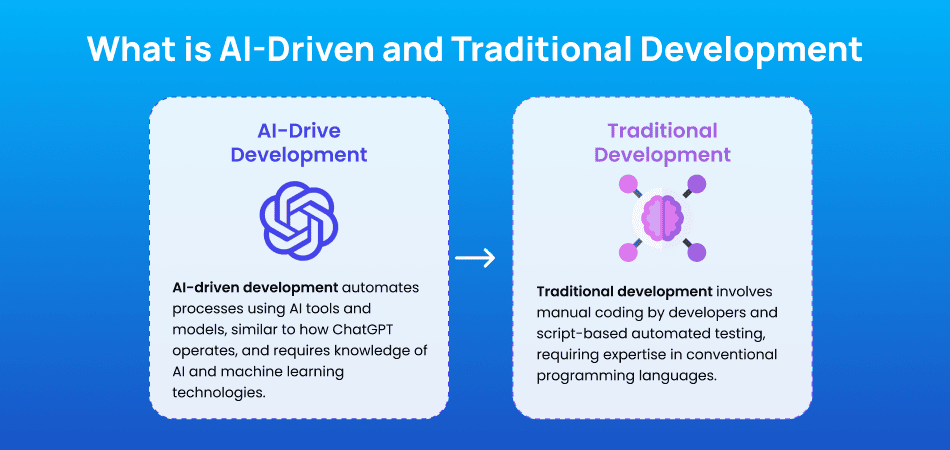
| Aspect | AI-Driven Development | Traditional Development |
| Code Generation | Automated using AI tools and models | Manual coding by developers |
| Testing | Intelligent, automated testing | Manual and script-based automated testing |
| Debugging | AI-driven, predictive debugging | Intuitive, experience-based debugging |
| Workflow | Non-linear, iterative, and adaptive | Linear, sequential, and structured |
| Efficiency | Higher due to automation and AI insights | Lower, depends on developer speed and accuracy |
| Cost | Potentially lower due to reduced manual effort | Potentially higher due to labor-intensive processes |
| Skill Requirements | Requires knowledge of AI and machine learning tools | Requires knowledge of traditional programming languages |
| Scalability | Easily scalable with AI algorithms | Scalability depends on manual intervention |
| Error Detection | Proactive error detection through predictive analytics | Reactive error detection through manual testing |
| Development Speed | Faster due to automation and AI-driven processes | Slower, depends on developer efficiency |
Advantages of AI-Driven Development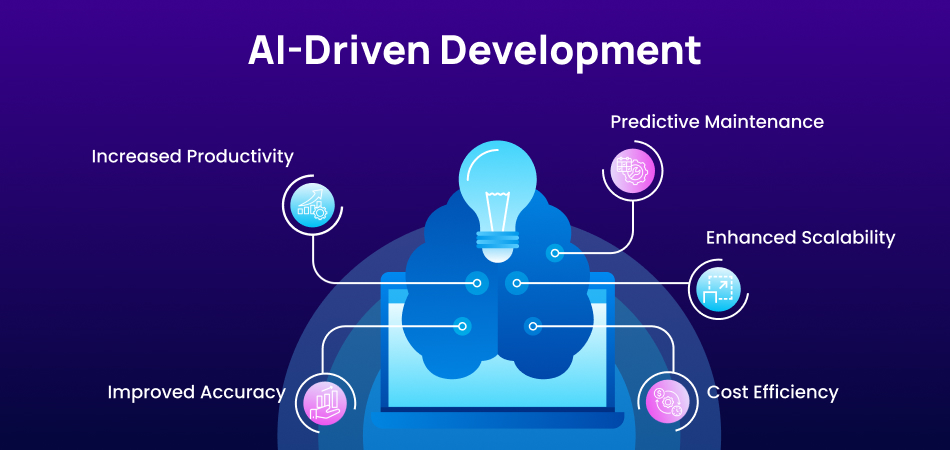
- Increased ProductivityAI-driven development automates repetitive tasks, freeing developers to focus on more complex and creative aspects of the project. This increased productivity can lead to faster development cycles and quicker time-to-market.
- Improved AccuracyAI algorithms can detect and correct errors with greater precision than humans, reducing the likelihood of bugs and issues. This improved accuracy enhances the overall quality of the software.
- Cost EfficiencyBy automating many aspects of development, AI-driven processes can reduce the need for extensive human labor, leading to lower development costs. Additionally, faster development times can result in significant cost savings.
- Enhanced ScalabilityAI-driven development processes can easily scale to accommodate larger projects and more complex requirements. AI tools can manage increased workloads without a proportional increase in resources.
- Predictive MaintenanceAI tools can analyze data to predict potential issues and suggest preventive measures. This proactive approach to maintenance ensures smoother project execution and reduces downtime.
Essential Platforms for AI-Driven Development
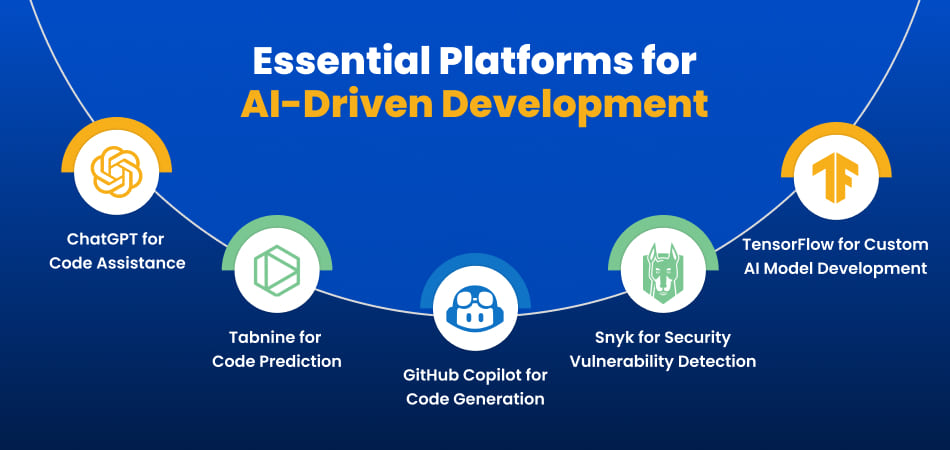
ChatGPT for Code Assistance
ChatGPT, an advanced AI language model developed by OpenAI, is widely used for code assistance and debugging. It helps developers by generating, explaining, and reviewing code snippets, offering solutions to common programming issues, and even assisting with complex algorithms. ChatGPT can interactively guide developers in understanding errors or optimizing code structures, which saves time and improves code quality. Its natural language capabilities make it accessible, allowing developers to query it conversationally, which reduces the learning curve.
Tabnine for Code Prediction
Tabnine is an AI-powered code completion tool designed to predict and suggest code snippets based on context. Leveraging deep learning models, Tabnine offers intelligent autocompletion, which reduces the amount of code that developers need to write manually. This tool learns from the codebase in real-time, providing accurate suggestions tailored to the project’s specific language and framework.
GitHub Copilot for Code Generation
GitHub Copilot, a collaboration between GitHub and OpenAI, is an AI-driven code generator that provides suggestions and code snippets based on comments or existing code. By analyzing millions of public repositories, Copilot offers relevant code that adapts to the developer’s coding style and requirements. This tool not only assists in code generation but also helps with documentation, making it easier for teams to maintain and understand the codebase.
Snyk for Security Vulnerability Detection
Snyk is an AI-driven tool focused on identifying and fixing vulnerabilities in code, dependencies, container images, and Infrastructure as Code (IaC). It integrates seamlessly into the development workflow, continuously scanning for security risks and offering suggestions for remediation. Snyk’s database is frequently updated, providing accurate and timely alerts about potential threats in third-party libraries or frameworks.
TensorFlow for Custom AI Model Development
TensorFlow is an open-source platform for creating and implementing machine learning models that was created by Google. It supports developers in designing custom models tailored to specific project needs, such as image recognition, natural language processing, or predictive analytics. TensorFlow’s flexibility allows it to be used for both large-scale enterprise solutions and small projects, enabling high levels of customization.
Advantages of Traditional Development
- Human Intuition:Experienced developers can leverage their intuition and creativity to solve unique and complex problems that AI might not be able to handle effectively. Human insight is invaluable for tasks that require nuanced understanding and innovation.
- Custom Solutions:Traditional development allows for highly customized solutions tailored to specific business needs. Developers can create bespoke software that precisely matches the client’s requirements.
- Greater Control:Manual processes provide developers with greater control over the development lifecycle and the final product. This control ensures that the software meets exact specifications and standards.
- Established Practices:Traditional methodologies have well-established practices and frameworks, ensuring reliability and consistency. These practices have been refined over years of industry experience.
Challenges of AI-Driven Development
- Learning CurveDevelopers need to acquire knowledge of AI tools and methodologies, which can be challenging and time-consuming. Training and education might have a substantial upfront cost.
- Initial CostsImplementing AI-driven solutions can involve high upfront costs, including software, hardware, and training. Businesses need to weigh these initial expenses against the long-term benefits.
- Dependence on DataAI algorithms require large amounts of data to function effectively. In some cases, collecting and managing this data can be difficult, especially for smaller projects or organizations with limited resources.
Challenges of Traditional Development
- Resource Intensive:Manual coding, testing, and debugging are labor-intensive and time-consuming processes. These activities can lead to higher development costs and longer project timelines.
- Higher Error Rates:Human error can result in bugs and issues that require significant effort to fix. The reliance on manual processes increases the likelihood of mistakes and inconsistencies.
- Slower Development:The sequential nature of traditional development can result in longer project timelines. Each phase must be completed before moving on to the next, which can slow down the overall process.
Choosing the Right Approach
Deciding between AI-driven and traditional development depends on various factors, including project requirements, budget, timeline, and available resources. Here are some considerations to help make the right choice:
- Project Complexity: For complex projects with repetitive tasks, AI-driven development can offer significant advantages in terms of efficiency and accuracy. AI tools can handle large volumes of data and complex algorithms more effectively than manual processes.
- Budget Constraints: Traditional development may be more suitable for projects with limited budgets and smaller scope. The initial costs of AI-driven development can be prohibitive for some organizations.
- Skill Availability: Consider the skills and expertise of your development team. If they have experience with AI tools, AI-driven development could be a viable option. Otherwise, traditional development may be more practical.
- Timeline: For projects with tight deadlines, AI-driven development can accelerate the development process and ensure timely delivery. Automation and predictive analytics can help meet stringent timelines.
Conclusion
Both AI-driven and traditional development approaches have their unique strengths and challenges. AI-driven development offers automation, efficiency, and scalability, making it ideal for large and complex projects. Traditional development, on the other hand, provides greater control, customization, and the benefit of human intuition, making it suitable for projects that require bespoke solutions. By understanding the key differences between these two approaches, businesses and developers can make informed decisions that align with their goals and resources.
Choosing the right development approach is crucial for the success of any software project. As AI technologies continue to evolve, the future of software development is likely to see even greater integration of AI-driven methodologies, paving the way for more innovative and efficient solutions. Whether opting for AI-driven or traditional development, the ultimate goal remains the same: to create high-quality software that meets user needs and drives business success.
